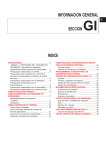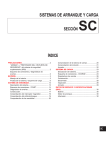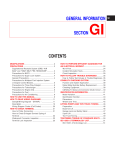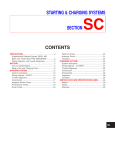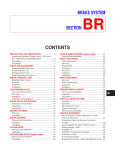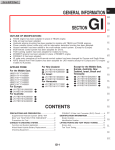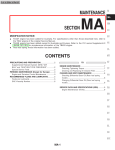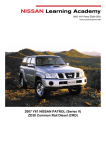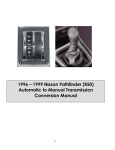Download GENERAL INFORMATION SECTION GI
Transcript
GENERAL INFORMATION SECTION GI CONTENTS PRECAUTIONS ...............................................................2 Supplemental Restraint System (SRS) ″AIR BAG″ and ″SEAT BELT PRE-TENSIONER″ (Dual Air Bag System) .................................................3 Precautions for NATS ..................................................4 Precautions for Multiport Fuel Injection System or Engine Control System ...........................................5 Precautions for Catalyst ..............................................5 Precautions for Turbocharger ......................................5 Precautions for Fuel ....................................................6 Precautions for Engine Oils.........................................6 HOW TO USE THIS MANUAL........................................8 HOW TO READ WIRING DIAGRAMS..........................10 Sample/Wiring Diagram - EXAMPL - ........................10 Description .................................................................12 HOW TO CHECK TERMINAL.......................................19 How to Probe Connectors .........................................19 How to Check Enlarged Contact Spring of Terminal .....................................................................20 Waterproof Connector Inspection ..............................21 Terminal Lock Inspection ...........................................21 HOW TO PERFORM EFFICIENT DIAGNOSIS FOR AN ELECTRICAL INCIDENT ........................................22 Work Flow..................................................................22 Incident Simulation Tests...........................................23 HOW TO FOLLOW FLOW CHART IN TROUBLE DIAGNOSES ..................................................................25 CONSULT-II CHECKING SYSTEM ...............................26 General ......................................................................26 Function and System Application ..............................26 Nickel Metal Hydride Battery Replacement...............27 Checking Equipment..................................................27 IDENTIFICATION INFORMATION.................................28 Model Variation ..........................................................28 Identification Number.................................................29 Dimensions ................................................................31 Wheels and Tires.......................................................31 LIFTING POINTS AND TOW TRUCK TOWING...........32 Garage Jack and Safety Stand .................................32 Screw Jack ................................................................32 4-pole Lift ...................................................................33 Tow Truck Towing ......................................................33 ISO 15031-2 TERMINOLOGY LIST ..............................35 ISO 15031-2 Terminology List ...................................35 TIGHTENING TORQUE OF STANDARD BOLTS ........38 PRECAUTIONS Observe the following precautions to ensure safe and proper servicing. These precautions are not described in each individual section. 1. Do not operate the engine for an extended period of time without proper exhaust ventilation. Keep the work area well ventilated and free of any inflammable materials. Special care should be taken when handling any inflammable or poisonous materials, such as gasoline, refrigerant gas, etc. When working in a pit or other enclosed area, be sure to properly ventilate the area before working with hazardous materials. Do not smoke while working on the vehicle. SGI285 2. Before jacking up the vehicle, apply wheel chocks or other tire blocks to the wheels to prevent the vehicle from moving. After jacking up the vehicle, support the vehicle weight with safety stands at the points designated for proper lifting and towing before working on the vehicle. These operations should be done on a level surface. 3. When removing a heavy component such as the engine or transaxle/transmission, take care not to lose your balance and drop it. Also, do not allow it to strike adjacent parts, especially the brake tubes and master cylinder. SGI231 4. Before starting repairs which do not require battery power, always turn off the ignition switch, then disconnect the ground cable from the battery to prevent accidental short circuit. SGI232 5. To prevent serious burns, avoid contact with hot metal parts such as the radiator, exhaust manifold, tail pipe and muffler. Do not remove the radiator cap when the engine is hot. SGI233 GI-2 PRECAUTIONS 6. Before servicing the vehicle, protect fenders, upholstery and carpeting with appropriate covers. Take caution that keys, buckles or buttons on your person do not scratch the paint. SGI234 7. Clean all disassembled parts in the designated liquid or solvent prior to inspection or assembly. 8. Replace oil seals, gaskets, packings, O-rings, locking washers, cotter pins, self-locking nuts, etc. with new ones. 9. Replace inner and outer races of tapered roller bearings and needle bearings as a set. 10. Arrange the disassembled parts in accordance with their assembled locations and sequence. 11. Do not touch the terminals of electrical components which use microcomputers (such as electronic control units). Static electricity may damage internal electronic components. 12. After disconnecting vacuum or air hoses, attach a tag to indicate the proper connection. 13. Use only the lubricants specified in MA section. 14. Use approved bonding agent, sealants or their equivalents when required. 15. Use tools and recommended special tools where specified for safe and efficient service repairs. 16. When repairing the fuel, oil, water, vacuum or exhaust systems, check all affected lines for leaks. 17. Dispose of drained oil or the solvent used for cleaning parts in an appropriate manner. Supplemental Restraint System (SRS) “AIR BAG” and “SEAT BELT PRE-TENSIONER” (Dual Air Bag System) SGI646 The Supplemental Restraint System “Air Bag” and “Seat Belt Pretensioner”, used along with a seat belt, help to reduce the risk or severity of injury to the driver and front passenger in a frontal collision. The Supplemental Restraint System consists of air bag modules (located in the center of the steering wheel and on the instrument panel on the passenger side), seat belt pre-tensioners, a diagnosis sensor unit, warning lamp, wiring harness and spiral cable. WARNING: I To avoid rendering the SRS inoperative, which could increase the risk of personal injury or death (in the event of a collision which would result in air bag inflation), all maintenance must be performed by an authorized NISSAN dealer. I Improper maintenance, including incorrect removal and installation of the SRS, can lead to personal injury caused by unintentional activation of the system. I Do not use electrical test equipment on any circuit related to the SRS unless instructed to do so in this Service Manual. SRS wiring harnesses are covered with yellow GI-3 PRECAUTIONS Supplemental Restraint System (SRS) “AIR BAG” and “SEAT BELT PRE-TENSIONER” (Dual Air Bag System) (Cont’d) insulation (either just before the harness connectors or for the complete harness), for easy identification. Precautions for NATS NATS (Nissan Anti-Theft System) SGI916 NATS will immobilize the engine if someone tries to start it without the registered key of NATS. Both of the originally supplied ignition key IDs have been NATS registered. The NATS security indicator is located on the instrument panel. The indicator blinks when the ignition switch is in “OFF” or “ACC” position. Therefore, NATS warns outsiders that the vehicle is equipped with the anti-theft system. I When NATS detects trouble, the malfunction indicator lamp (MIL) blinks. This blinking indicates that the anti-theft is not functioning, so prompt service is required. I If the malfunction indicator lamp comes on while the engine is running, return the vehicle to the workshop before turning the ignition switch “OFF”. Once the ignition switch is turned “OFF”, the engine can not be started. I When servicing NATS (trouble diagnoses, system initialization and additional registration of other NATS ignition key IDs) CONSULT-II hardware and CONSULT-II NATS software is necessary. Regarding the procedures of NATS initialization and NATS ignition key ID registration, refer to CONSULT-II operation manual, NATS. Therefore, CONSULT-II NATS software (program card and operation manual) must be kept strictly confidential to maintain the integrity of the anti-theft function. I When servicing NATS (trouble diagnoses, system initialization and additional registration of other NATS ignition key IDs), it may be necessary to re-register original key identification. Therefore, be sure to receive all keys from vehicle owner. A maximum of five key IDs can be registered into NATS. I When failing to start the engine first-time using the key of NATS, starts as follows: (1) Turn ignition key to “OFF”. (2) Wait approx. 5 seconds. (3) Turn ignition key to “START” again while keeping the key apart from any others on key-chain. GI-4 PRECAUTIONS Precautions for Multiport Fuel Injection System or Engine Control System SGI787 1. Before connecting or disconnecting any harness connector for the multiport fuel injection system or ECM (Engine Control Module): Turn ignition switch to “OFF” position. Disconnect negative battery terminal. Otherwise, there may be damage to ECM. 2. Before disconnecting pressurized fuel line from fuel pump to injectors, be sure to release fuel pressure to eliminate danger. 3. Be careful not to jar components such as control unit and air flow meter. Precautions for Catalyst SGI290 If a large amount of unburned fuel enters the converter, the converter temperature will rise to excessively high values. To prevent this, follow the procedure below: 1. Use unleaded gasoline only. Leaded gasoline will seriously damage the catalytic converter. 2. When checking for ignition spark or measuring engine compression, perform tests quickly and only when necessary. 3. Do not run engine when the fuel tank level is low, as a result the engine may misfire causing damage to the converter. 4. Do not place the vehicle on inflammable material. Keep inflammable material off the exhaust pipe. Precautions for Turbocharger SGI292 The turbocharger turbine revolves at extremely high speeds and becomes very hot. Therefore, it is essential to maintain a clean supply of oil flowing through the turbocharger and to follow all required maintenance instructions and operating procedures. For proper operation of the system, follow the procedure below: 1. Always use the recommended oil. Follow the instructions for proper time to change the oil and proper oil level. 2. Avoid accelerating engine to a high rpm immediately after starting. 3. If engine had been operating at high rpm for an extended period of time, let it idle for a few minutes prior to shutting it off. GI-5 PRECAUTIONS Precautions for Fuel DIESEL ENGINE*: Diesel fuel of at least 50 cetane for ZD30DDTi engine. * If two types of diesel fuel are available, use summer or winter fuel properly according to the following temperature conditions. I Above −7°C (20°F) ... Summer type diesel fuel. I Below −7°C (20°F) ... Winter type diesel fuel. CAUTION: I Do not use home heating oil, gasoline, or other alternate fuels in your diesel engine. The use of those can cause engine damage. I Do not use summer fuel at temperature below −7°C (20°F). The cold temperature will cause wax to form in the fuel. As a result, it may prevent the engine from running smoothly. I Do not add gasoline or other alternate fuels to diesel fuel. Precautions for Engine Oils Prolonged and repeated contact with mineral oil will result in the removal of natural fats from the skin, leading to dryness, irritation and dermatitis. In addition, used engine oil contains potentially harmful contaminants which may cause skin cancer. Adequate means of skin protection and washing facilities must be provided. HEALTH PROTECTION PRECAUTIONS 1. Avoid prolonged and repeated contact with oils, particularly used engine oils. 2. Wear protective clothing, including impervious gloves where practicable. 3. Do not put oily rags in pockets. 4. Avoid contaminating clothes, particularly underwear, with oil. 5. Heavily soiled clothing and oil-impregnated footwear should not be worn. Overalls must be cleaned regularly. 6. First Aid treatment should be obtained immediately for open cuts and wounds. 7. Use barrier creams, applying them before each work period, to help the removal of oil from the skin. 8. Wash with soap and water to ensure all oil is removed (skin cleansers and nail brushes will help). Preparations containing lanolin replace the natural skin oils which have been removed. 9. Do not use petrol, kerosine, diesel fuel, gas oil, thinners or solvents for cleaning skin. 10. If skin disorders develop, obtain medical advice without delay. 11. Where practicable, degrease components prior to handling. 12. Where there is a risk of eye contact, eye protection should be worn, for example, chemical goggles or face shields; in addition an eye wash facility should be provided. (For the United Kingdom, see also HSE Cautionary Notice SHW 397 “Effects of Mineral Oil on the Skin”.) ENVIRONMENTAL PROTECTION PRECAUTIONS Burning used engine oil in small space heaters or boilers can be recommended only for units of approved design. The heating system must meet the requirements of HM Inspectorate of Pollution for small burners of less than 0.4 MW. If in doubt check with the appropriate local authority and/or manufacturer of the approved appliance. GI-6 PRECAUTIONS Precautions for Engine Oils (Cont’d) Dispose of used oil and used oil filters through authorized waste disposal contractors to licensed waste disposal sites, or to the waste oil reclamation trade. If in doubt, contact the local authority for advice on disposal facilities. It is illegal to pour used oil on to the ground, down sewers or drains, or into water courses. The regulations concerning the pollution of the environment will vary from country to country. GI-7 HOW TO USE THIS MANUAL 1. A QUICK REFERENCE INDEX, a black tab (e.g. ) is provided on the first page. You can quickly find the first page of each section by mating it to the section’s black tab. 2. THE CONTENTS are listed on the first page of each section. 3. THE TITLE is indicated on the upper portion of each page and shows the part or system. 4. THE PAGE NUMBER of each section consists of two letters which designate the particular section and a number (e.g. “BR-5”). 5. THE LARGE ILLUSTRATIONS are exploded views (See below) and contain tightening torques, lubrication points and other information necessary to perform repairs. The illustrations should be used in reference to service matters only. When ordering parts, refer to the appropriate PARTS CATALOG. SBR364A 6. THE SMALL ILLUSTRATIONS show the important steps such as inspection, use of special tools, knacks of work and hidden or tricky steps which are not shown in the previous large illustrations. Assembly, inspection and adjustment procedures for the complicated units such as the automatic transaxle or transmission, etc. are presented in a step-by-step format where necessary. GI-8 HOW TO USE THIS MANUAL 7. The following SYMBOLS AND ABBREVIATIONS are used: q P , : Tightening torque : Should be lubricated with grease. A.T.F. Unless otherwise indicated, use rec★ ommended multi-purpose grease. ✩ : Should be lubricated with oil. M/T : Sealing point A/C P/S : Checking point S.S.T. : Always replace after every disassemS.D.S. bly. SAE L.H., R.H.: Left-Hand, Right-Hand L.H.D. FR, RR : Front, Rear R.H.D. 2WD : 2-Wheel Drive 4WD : 4-Wheel Drive : : : : : : : : : : : : : Apply petroleum jelly. Apply A.T.F. Automatic Transmission Fluid Select with proper thickness. Adjustment is required. Manual Transaxle/Transmission Air Conditioner Power Steering Special Service Tools Service Data and Specifications Society of Automotive Engineers, Inc. Left-Hand Drive Right-Hand Drive 8. The UNITS given in this manual are primarily expressed as the SI UNIT (International System of Unit), and alternatively expressed in the metric system and in the yard/pound system. “Example” Tightening torque: 59 - 78 N⋅m (6.0 - 8.0 kg-m, 43 - 58 ft-lb) 9. TROUBLE DIAGNOSES are included in sections dealing with complicated components. 10. SERVICE DATA AND SPECIFICATIONS are contained at the end of each section for quick reference of data. 11. The captions WARNING and CAUTION warn you of steps that must be followed to prevent personal injury and/or damage to some part of the vehicle. I WARNING indicates the possibility of personal injury if instructions are not followed. I CAUTION indicates the possibility of component damage if instructions are not followed. I BOLD TYPED STATEMENTS except WARNING and CAUTION give you helpful information. GI-9 HOW TO READ WIRING DIAGRAMS Sample/Wiring Diagram — EXAMPL — I For Description, refer to GI-10. YGI001 GI-10 HOW TO READ WIRING DIAGRAMS Sample/Wiring Diagram — EXAMPL — (Cont’d) OPTIONAL SPLICE SGI942 GI-11 HOW TO READ WIRING DIAGRAMS Description Number Item Description q 1 Power condition I This shows the condition when the system receives battery positive voltage (can be operated). q 2 Fusible link I The double line shows that this is a fusible link. I The open circle shows current flow in, and the shaded circle shows current flow out. q 3 Fusible link/fuse location I This shows the location of the fusible link or fuse in the fusible link or fuse box. For arrangement, refer to EL section (“POWER SUPPLY ROUTING”). q 4 Fuse I The single line shows that this is a fuse. I The open circle shows current flow in, and the shaded circle shows current flow out. q 5 Current rating I This shows the current rating of the fusible link or fuse. q 6 Connectors I This shows that connector E3 is female and connector M1 is male. I The G/R wire is located in the 1A terminal of both connectors. I Terminal number with an alphabet (1A, 5B, etc.) indicates that the connector is SMJ connector. Refer to GI-18. q 7 Optional splice I The open circle shows that the splice is optional depending on vehicle application. q 8 Splice I The shaded circle shows that the splice is always on the vehicle. q 9 Page crossing I This arrow shows that the circuit continues to an adjacent page. I The A will match with the A on the preceding or next page. q 10 Common connector I The dotted lines between terminals show that these terminals are part of the same connector. q 11 Option abbreviation I This shows that the circuit is optional depending on vehicle application. q 12 Relay I This shows an internal representation of the relay. For details, refer to EL section (“STANDARDIZED RELAY”). q 13 Connectors I This shows that the connector is connected to the body or a terminal with bolt or nut. q 14 Wire color I This shows a code for the color of the wire. B = Black BR = Brown W = White OR = Orange R = Red P = Pink G = Green PU = Purple L = Blue GY = Gray Y = Yellow SB = Sky Blue LG = Light Green CH = Dark Brown DG = Dark Green When the wire color is striped, the base color is given first, followed by the stripe color as shown below: Example: L/W = Blue with White Stripe q 15 Option description I This shows a description of the option abbreviation used on the page. q 16 Switch I This shows that continuity exists between terminals 1 and 2 when the switch is in the A position. Continuity exists between terminals 1 and 3 when the switch is in the B position. q 17 Assembly parts I Connector terminal in component shows that it is a harness incorporated assembly. q 18 Cell code I This identifies each page of the wiring diagram by section, system and wiring diagram page number. GI-12 HOW TO READ WIRING DIAGRAMS Description (Cont’d) Number Item Description q 19 Current flow arrow I Arrow indicates electric current flow, especially where the direction of standard flow (vertically downward or horizontally from left to right) is difficult to follow. I A double arrow “F—E” shows that current can flow in either direction depending on circuit operation. q 20 System branch I This shows that the system branches to another system identified by cell code (section and system). q 21 Page crossing I This arrow shows that the circuit continues to another page identified by cell code. I The C will match with the C on another page within the system other than the next or preceding pages. q 22 Shielded line I The line enclosed by broken line circle shows shield wire. q 23 Component box in wave line I This shows that another part of the component is also shown on another page (indicated by wave line) within the system. q 24 Component name I This shows the name of a component. q 25 Connector number I This shows the connector number. I The letter shows which harness the connector is located in. Example: M: main harness. For detail and to locate the connector, refer to EL section (“Main Harness”, “HARNESS LAYOUT”). A coordinate grid is included for complex harnesses to aid in locating connectors. q 26 Ground (GND) I The line spliced and grounded under wire color shows that ground line is spliced at the grounded connector. q 27 Ground (GND) I This shows the ground connection. q 28 Connector views I This area shows the connector faces of the components in the wiring diagram on the page. q 29 Common component I Connectors enclosed in broken line show that these connectors belong to the same component. q 30 Connector color I This shows a code for the color of the connector. For code meaning, refer to wire color codes, Number q 14 of this chart. q 31 Fusible link and fuse box I This shows the arrangement of fusible link(s) and fuse(s), used for connector views of “POWER SUPPLY ROUTING” in EL section. The open square shows current flow in, and the shaded square shows current flow out. q 32 Reference area I This shows that more information on the Super Multiple Junction (SMJ) and Joint Connectors (J/C) exists on the foldout page. Refer to GI-18 for details. GI-13 HOW TO READ WIRING DIAGRAMS Description (Cont’d) CONNECTOR SYMBOLS Most of connector symbols in wiring diagrams are shown from the terminal side. I Connector symbols shown from the terminal side are enclosed by a single line and followed by the direction mark . I Connector symbols shown from the harness side are enclosed . by a double line and followed by the direction mark I Male and female terminals Connector guides for male terminals are shown in black and female terminals in white in wiring diagrams. SGI364 SGI363 GI-14 HOW TO READ WIRING DIAGRAMS Description (Cont’d) Harness indication I I Letter designations next to test meter probe indicate harness (connector) wire color. Connector numbers in a single circle M33 indicate harness connectors. Component indication I Connector numbers in a double circle indicate component connectors. AGI070 SWITCH POSITIONS Switches are shown in wiring diagrams as if the vehicle is in the “normal” condition. A vehicle is in the “normal” condition when: I ignition switch is “OFF”, I doors, hood and trunk lid/back door are closed, I pedals are not depressed, and I parking brake is released. SGI860 GI-15 HOW TO READ WIRING DIAGRAMS Description (Cont’d) DETECTABLE LINES AND NON-DETECTABLE LINES In some wiring diagrams, two kinds of lines, representing wires, with different weight are used. I A line with regular weight (wider line) represents a “detectable line for DTC (Diagnostic Trouble Code)”. A “detectable line for DTC” is a circuit in which ECM (Engine Control Module) can detect its malfunctions with the on board diagnostic system. I A line with less weight (thinner line) represents a “non-detectable line for DTC”. A “non-detectable line for DTC” is a circuit in which ECM cannot detect its malfunctions with the on board diagnostic system. SGI862-A GI-16 HOW TO READ WIRING DIAGRAMS Description (Cont’d) MULTIPLE SWITCH The continuity of multiple switch is described in two ways as shown below. I The switch chart is used in schematic diagrams. I The switch diagram is used in wiring diagrams. SGI875 GI-17 HOW TO READ WIRING DIAGRAMS Description (Cont’d) FOLDOUT PAGE The foldout page should be opened when reading wiring diagram. Super multiple junction (SMJ) In wiring diagram, connectors consisting of terminals having terminal numbers with an alphabet (1B, 0D, etc.) are SMJ connectors. If connector numbers are shown in Reference Area, these connector symbols are not shown in Connector Area. For terminal arrangement of these connectors, refer to the foldout page at the end of this manual. Joint connector Joint connector symbols are shown in Connector Area in the wiring diagram concerned. Foldout page also carries inside wiring layout together with such joint connector symbols. SGI943 GI-18 HOW TO CHECK TERMINAL How to Probe Connectors Connector damage and an intermittent connection can result from improperly probing of the connector during circuit checks. The probe of a digital multimeter (DMM) may not correctly fit the connector cavity. To correctly probe the connector, follow the procedures below using a “T” pin. For the best contact grasp the “T” pin using an alligator clip. PROBING FROM HARNESS SIDE Standard type (not waterproof type) connector should be probed from harness side with “T” pin. I If the connector has a rear cover such as a ECM connector, remove the rear cover before probing the terminal. I Do not probe waterproof connector from harness side. Damage to the seal between wire and connector may result. SGI841 PROBING FROM TERMINAL SIDE Female terminal I There is a small notch above each female terminal. Probe each terminal with the “T” pin through the notch. Do not insert any object other than the same type male terminal into female terminal. SEL265V I Some connectors do not have a notch above each terminal. To probe each terminal, remove the connector retainer to make contact space for probing. SEL266V Male terminal Carefully probe the contact surface of each terminal using a “T” pin. Do not bend terminal. SEL267V GI-19 HOW TO CHECK TERMINAL How to Check Enlarged Contact Spring of Terminal An enlarged contact spring of a terminal may create intermittent signals in the circuit. If the intermittent open circuit occurs, follow the procedure below to inspect for open wires and enlarged contact spring of female terminal. 1. Assemble a male terminal and approx. 10 cm (3.9 in) of wire. Use a male terminal which matches the female terminal. 2. Disconnect the suspected faulty connector and hold it terminal side up. SEL270V 3. While holding the wire of the male terminal, try to insert the male terminal into the female terminal. Do not force the male terminal into the female terminal with your hands. SEL271V 4. While moving the connector, check whether the male terminal can be easily inserted or not. SEL272V I If the male terminal can be easily inserted into the female terminal, replace the female terminal. SEL273V GI-20 HOW TO CHECK TERMINAL Waterproof Connector Inspection If water enters the connector, it can short interior circuits. This may lead to intermittent problems. Check the following items to maintain the original waterproof characteristics. RUBBER SEAL INSPECTION I SEL275V I Most waterproof connectors are provided with a rubber seal between the male and female connectors. If the seal is missing, the waterproof performance may not meet specifications. The rubber seal may come off when connectors are disconnected. Whenever connectors are reconnected, make sure the rubber seal is properly installed on either side of male or female connector. WIRE SEAL INSPECTION The wire seal must be installed on the wire insertion area of a waterproof connector. Be sure that the seal is installed properly. Terminal Lock Inspection Check for unlocked terminals by pulling wire at the end of connector. An unlocked terminal may create intermittent signals in the circuit. SEL330V GI-21 HOW TO PERFORM EFFICIENT DIAGNOSIS FOR AN ELECTRICAL INCIDENT Work Flow SGI838 STEP STEP 1 DESCRIPTION Get detailed information about the conditions and the environment when the incident occurred. The following are key pieces of information required to make a good analysis: WHAT Vehicle Model, Engine, Transmission and the System (i.e. Radio). WHEN Date, Time of Day, Weather Conditions, Frequency. WHERE Road Conditions, Altitude and Traffic Situation. HOW System Symptoms, Operating Conditions (Other Components Interaction). Service History and if any After Market Accessories have been installed. STEP 2 Operate the system, road test if necessary. Verify the parameter of the incident. If the problem cannot be duplicated, refer to “Incident Simulation Tests” next page. STEP 3 Get the proper diagnosis materials together including: POWER SUPPLY ROUTING System Operation Descriptions Applicable Service Manual Sections Check for any Service Bulletin. Identify where to begin diagnosis based upon your knowledge of the system operation and the customer comments. STEP 4 Inspect the system for mechanical binding, loose connectors or wiring damage. Determine which circuits and components are involved and diagnose using the Power Supply Routing and Harness Layouts. STEP 5 Repair or replace the incident circuit or component. STEP 6 Operate the system in all modes. Verify the system works properly under all conditions. Make sure you have not inadvertently created a new incident during your diagnosis or repair steps. GI-22 HOW TO PERFORM EFFICIENT DIAGNOSIS FOR AN ELECTRICAL INCIDENT Incident Simulation Tests INTRODUCTION Sometimes the symptom is not present when the vehicle is brought in for service. If possible, re-create the conditions present at the time of the incident. Doing so may help avoid a No Trouble Found Diagnosis. The following section illustrates ways to simulate the conditions/environment under which the owner experiences an electrical incident. The section is broken into the six following topics: I Vehicle vibration I Heat sensitive I Freezing I Water intrusion I Electrical load I Cold or hot start up Get a thorough description of the incident from the customer. It is important for simulating the conditions of the problem. VEHICLE VIBRATION The problem may occur or become worse while driving on a rough road or when engine is vibrating (idle with A/C on). In such a case, you will want to check for a vibration related condition. Refer to the illustration below. Connectors & harness Determine which connectors and wiring harness would affect the electrical system you are inspecting. Gently shake each connector and harness while monitoring the system for the incident you are trying to duplicate. This test may indicate a loose or poor electrical connection. Hint Connectors can be exposed to moisture. It is possible to get a thin film of corrosion on the connector terminals. A visual inspection may not reveal this without disconnecting the connector. If the problem occurs intermittently, perhaps the problem is caused by corrosion. It is a good idea to disconnect, inspect and clean the terminals on related connectors in the system. Sensors & relays Gently apply a slight vibration to sensors and relays in the system you are inspecting. This test may indicate a loose or poorly mounted sensor or relay. SGI839 GI-23 HOW TO PERFORM EFFICIENT DIAGNOSIS FOR AN ELECTRICAL INCIDENT Incident Simulation Tests (Cont’d) Engine compartment There are several reasons a vehicle or engine vibration could cause an electrical complaint. Some of the things to check for are: I I I I I Connectors not fully seated. Wiring harness not long enough and is being stressed due to engine vibrations or rocking. Wires laying across brackets or moving components. Loose, dirty or corroded ground wires. Wires routed too close to hot components. To inspect components under the hood, start by verifying the integrity of ground connections. (Refer to GROUND INSPECTION described later.) First check that the system is properly grounded. Then check for loose connection by gently shaking the wiring or components as previously explained. Using the wiring diagrams inspect the wiring for continuity. Behind the instrument panel An improperly routed or improperly clamped harness can become pinched during accessory installation. Vehicle vibration can aggravate a harness which is routed along a bracket or near a screw. Under seating areas An unclamped or loose harness can cause wiring to be pinched by seat components (such as slide guides) during vehicle vibration. If the wiring runs under seating areas, inspect wire routing for possible damage or pinching. HEAT SENSITIVE The owner’s problem may occur during hot weather or after car has sat for a short time. In such cases you will want to check for a heat sensitive condition. To determine if an electrical component is heat sensitive, heat the component with a heat gun or equivalent. Do not heat components above 60°C (140°F). If incident occurs while heating the unit, either replace or properly insulate the component. SGI842 GI-24 HOW TO FOLLOW FLOW CHART IN TROUBLE DIAGNOSES Key to symbols signifying measurements or procedures Symbol Symbol explanation Symbol Symbol explanation Check after disconnecting the connector to be measured. Circuit resistance should be measured with an ohmmeter. Check after connecting the connector to be measured. Current should be measured with an ammeter. Insert key into ignition switch. Procedure with CONSULT-II Remove key from ignition switch. Procedure without CONSULT-II Turn ignition switch to “OFF” position. A/C switch is “OFF”. Turn ignition switch to “ON” position. A/C switch is “ON”. Turn ignition switch to “START” position. Fan switch is “ON”. (At any position except for “OFF” position) Turn ignition switch from “OFF” to “ACC” position. Fan switch is “OFF”. Turn ignition switch from “ACC” to “OFF” position. Apply battery voltage directly to components. Turn ignition switch from “OFF” to “ON” position. Drive vehicle. Turn ignition switch from “ON” to “OFF” position. Disconnect battery negative cable. Do not start engine, or check with engine stopped. Depress brake pedal. Start engine, or check with engine running. Release brake pedal. Apply parking brake. Depress accelerator pedal. Release parking brake. Release accelerator pedal. Check after engine is warmed up sufficiently. Voltage should be measured with a voltmeter. GI-25 Pin terminal check for SMJ type connector (e.g. ECM and TCM, etc.) For details regarding the terminal arrangement, refer to the foldout page. CONSULT-II CHECKING SYSTEM SGI619 General The R20 model as outlined in this supplement is equipped with the DDL-1 connector which is compatible with both CONSULT and CONSULT-II. During the establishment of this supplement, the CONSULT-II has been utilised. Function and System Application Diagnostic test mode Self-diagnostic results ECU discriminated No. Data monitor Active test ECM part number Control unit initialisation Self-function check Function ENGINE Air bag ABS NATS*1 Self-diagnostic results can be read and erased quickly. Classification number of a replacement ECU can be read to prevent an incorrect ECU from being installed. Input/Output data in the ECM can be read. Diagnostic Test Mode in which CONSULT-II drives some actuators apart from the ECMs and also shifts some parameters in a specified range. ECM part number can be read. All registered ignition key IDs in NATS components can be initialised and new IDs can be registered. ECM checks its own NATS communication interface. x x x x — x — — x — x — x — x — x — x — — — — x — — — x x: Applicable *1: NATS: Nissan Anti-Theft System GI-26 CONSULT-II CHECKING SYSTEM Nickel Metal Hydride Battery Replacement CONSULT-II contains a nickel metal hydride battery. When replacing the battery obey the following: WARNING: Replace the nickel metal hydride battery with genuine CONSULT-II battery only. Use of another battery may present a risk of fire or explosion. The battery may present a fire or chemical burn hazard if mistreated. Do not recharge, disassemble of dispose of in fire. Keep the battery out of reach of children and discard used battery conforming to the local regulations. Checking Equipment When ordering this equipment, contact your NISSAN distributor. Tool name Description NISSAN CONSULT-II q 1 CONSULT-II unit and accessories q 2 Program card AED01B-1 for diagnosis, AEN00B for NATS YGI004 NOTE: I The CONSULT-II must be used in conjunction with a program card. CONSULT-II does not require loading (Initialisation) procedure. I Be sure the CONSULT-II is turned off before installing or removing a program card. GI-27 IDENTIFICATION INFORMATION Model Variation Body Grade Engine Transmission Group A (RHD) Group B (South) Group C (Central) Group D (North) SE “Luxury/ Elegance” TD27Ti FS5R30A KVPNRVF-UEC KVPNLVF-UGC KVPNLVF-USC FS5R30A KWSNRVF-UEC KWSNLVF-UGC KWSNLVF-USC RE4R01A KWSNRVA-UEC KWSNLVA-UGC KWSNLVA-USC FS5R30A KVPNRUF-UEC KVPNLUF-UGC KVPNLUF-USC FS5R30A KWSNRUF-UEC KWSNLUF-UGC KWSNLUF-USC RE4R01A KWSNRUA-UEC KWSNLUA-UGC KWSNLUA-USC TD27Ti FS5R30A KVPNRQF-UEC KVPNLQF-UGC KVPNLQF-USC TD27Ti FS5R30A TVPURVF-UEC TVPULVF-UGC TVPULVF-USC FS5R30A TWSURVF-UEC TWSULVF-UGC TWSULVF-USC RE4R01A TWSURVA-UEC TWSULVA-UGC TWSULVA-USC ZD30ETi TD27Ti H/T SR “Sport” ZD30ETi S “Comfort” SE “Luxury/ Elegance” ZD30ETi TD27Ti Wagon SR “Sport” FS5R30A TVPURUF-UEC TVPULUF-UGC TVPULUF-USC FS5R30A TWSURUF-UEC TWSULUF-UGC TWSULUF-USC RE4R01A TWSURUA-UEC TWSULUA-UGC TWSULUA-USC FS5R30A TVPURQF-UEC TVPULQF-UGC TVPULQF-USC ZD30ETi S “Comfort” TD27Ti Prefix and suffix designations: K BF N L V F R20 E G C C : Standard E : RHD models G : South/Central Europe S : North Europe U : Turbo F : 5-speed manual transmission A : Automatic transmission Q : S grade U : SR grade V : SE grade L : Left-hand drive R : Right-hand drive N : 4-wheel drive, short wheelbase U : 4-wheel drive, long wheelbase VP : TD27Ti engine WS : ZD30DDTi engine K : Hardtop T : Wagon GI-28 IDENTIFICATION INFORMATION Identification Number EGI013 VEHICLE IDENTIFICATION NUMBER (Chassis number) Prefix and suffix designations: VSK K B N R20 U O XXXXXX Vehicle serial number Stopgap (no meaning) U : Europe Model Axle N : 4-wheel drive, short wheelbase U : 4-wheel drive, long wheelbase Engine V : TD27Ti X : ZD30DDTi Body K : Hardtop T : Wagon Manufacturer code GI-29 IDENTIFICATION INFORMATION Identification Number (Cont’d) IDENTIFICATION PLATE NGI011 ENGINE SERIAL NUMBER NGI012 AUTOMATIC TRANSMISSION NUMBER SGI137A MANUAL TRANSMISSION NUMBER SGI760-A GI-30 NGI014 IDENTIFICATION INFORMATION Dimensions Unit: mm (in) Hardtop Wagon Overall length 4,242 (167.0) 4,722 (185.9) Overall width (*) 1,755 (69.1) 1,755 (69.1) Overall height 1,805 (71.1) 1,810 (71.3) Front tread 1,455 (57.3) 1,455 (57.3) Rear tread 1,430 (56.3) 1,430 (56.3) Wheelbase 2,450 (96.5) 2,650 (104.3) Ground clearance 210 (8.3) 205 (8.1) Front overhang 837 (33.0) 837 (33.0) bumper 835 (32.9) 1,115 (43.9) spare wheel 955 (37.6) 1,235 (48.6) Rear overhang (*): without mirrors Wheels and Tires Road wheel size Offset 16 x 7J [mm (in)] Tire size GI-31 25 (0.98) 235/70 R16 LIFTING POINTS AND TOW TRUCK TOWING Garage Jack and Safety Stand WARNING: I Never get under the vehicle while it is supported only by the jack. Always use safety stands when you have to get under the vehicle. I Place wheel chocks at both front and back of the wheels on the ground, and apply handbrake where appropriate. I Do not start the engine while the vehicle is supported only by the jack. EGI016 Screw Jack EGI017 GI-32 LIFTING POINTS AND TOW TRUCK TOWING 4-pole Lift WARNING: Do not use a 2-pole lift. Due to weight balance of the vehicle and shape of underbody, lift arms can not be attached in a safe way. Therefore it is recommended to use a 4-pole lift only. Tow Truck Towing CAUTION: I All applicable local laws regarding the towing operation must be obeyed. I It is necessary to use proper towing equipment to avoid possible damage to the vehicle during a towing operation. I Attach safety chains for all towing. I When towing, make sure that the transmission, steering system and power train are in good order. If any unit is damaged, a dolly must be used. I When towing with the front wheels on the ground: Move both the gearshift and transfer levers to neutral (“N” position). Turn the ignition key to the “OFF” position and secure the steering wheel in a straightahead position with a rope or similar device. Never place the ignition key in the “LOCK” position. This will result in damage to the steering lock mechanism. I When towing with the rear wheels on the ground, release the parking brake and move both the gearshift and transfer levers to neutral (“N” position). I Never tow vehicle from the rear (i.e., backward) with four wheels on the ground as this may cause serious and expensive damage to the transmission. GI-33 LIFTING POINTS AND TOW TRUCK TOWING Tow Truck Towing (Cont’d) NISSAN recommends that a dolly be used as illustrated when towing 4-wheel drive models. EGI018 Towing with four wheels on ground or towing with front (rear wheels on ground) or rear wheels (front wheels on ground) raised Observe the following restricted towing speeds and distances. Speed: Below 50 km/h (30 MPH) Distance: Less than 65 km (40 miles) If the speed or distance must necessarily be greater, remove the front and rear propeller shafts beforehand to prevent damage to the transmission. TOWING POINT I I Always pull the cable straight out from the vehicle. Never pull on the hook at a sideways angle. Use proper towing equipment when towing. Otherwise, the vehicle body will be damaged. Front I Only R.H. hook may be used for towing purposes. Use L.H. hook only for securing the vehicle during transportation. EGI019 Rear I Either hook can be used for towing purposes. A platform should be used. EGI020 GI-34 ISO 15031-2 TERMINOLOGY LIST ISO 15031-2 Terminology List All emission related terms used in this publication in accordance with ISO 15031-2 are listed. Accordingly, new terms, new acronyms/abbreviations and old terms are listed in the following chart. ***: Not applicable NEW ACRONYM/ ABBREVIATION NEW TERM OLD TERM Air cleaner ACL Air cleaner Barometric pressure BARO Barometric pressure sensor-BCDD BAROS-BCDD BCDD Camshaft position CMP *** Camshaft position sensor CMPS Crank angle sensor Carburetor CARB Carburetor Charge air cooler CAC Intercooler Closed loop CL Closed loop Closed throttle position switch CTP switch Idle switch Clutch pedal position switch CPP switch Clutch switch Continuous fuel injection system CFI system *** Continuous trap oxidizer system CTOX system *** Crankshaft position CKP *** Crankshaft position sensor CKPS *** Data link connector DLC *** Data link connector for CONSULT DLC for CONSULT Diagnostic connector for CONSULT Diagnostic test mode DTM Diagnostic mode Diagnostic test mode selector DTM selector Diagnostic mode selector Diagnostic test mode I DTM I Mode I Diagnostic test mode II DTM II Mode II Diagnostic trouble code DTC Malfunction code Direct fuel injection system DFI system *** Distributor ignition system DI system Ignition timing control Early fuel evaporation-mixture heater EFE-mixture heater Mixture heater Early fuel evaporation system EFE system Mixture heater control Electrically erasable programmable read only memory EEPROM *** Electronic ignition system EI system Ignition timing control Engine control module ECM ECCS control unit Engine coolant temperature ECT Engine temperature Engine coolant temperature sensor ECTS Engine temperature sensor Engine modification EM *** Engine speed RPM Engine speed Erasable programmable read only memory EPROM *** Evaporative emission system EVAP system Evaporative emission control system Exhaust gas recirculation valve EGR valve EGR valve Exhaust gas recirculation control-BPT valve EGRC-BPT valve BPT valve Exhaust gas recirculation control-solenoid valve EGRC-solenoid valve EGR control solenoid valve GI-35 ISO 15031-2 TERMINOLOGY LIST ISO 15031-2 Terminology List (Cont’d) ***: Not applicable NEW ACRONYM/ ABBREVIATION NEW TERM OLD TERM Exhaust gas recirculation temperature sensor EGR temperature sensor Exhaust gas temperature sensor Flash electrically erasable programmable read only memory FEEPROM *** Flash erasable programmable read only memory FEPROM *** Flexible fuel sensor FFS *** Flexible fuel system FF system *** Heated Oxygen sensor HO2S Exhaust gas sensor Idle air control system IAC system Idle speed control Idle air control valve-air regulator IACV-air regulator Air regulator Idle air control valve-auxiliary air control valve IACV-AAC valve Auxiliary air control (AAC) valve Idle air control valve-FICD solenoid valve IACV-FICD solenoid valve FICD solenoid valve Idle air control valve-idle up control solenoid valve IACV-idle up control solenoid valve Idle up control solenoid valve Idle speed control-FI pot ISC-FI pot FI pot Idle speed control system ISC system *** Ignition control module ICM *** Indirect fuel injection system IFI system *** Intake air temperature sensor IATS Air temperature sensor Knock *** Detonation Knock sensor KS Detonation sensor Malfunction indicator MI Check engine light Manifold absolute pressure MAP *** Manifold absolute pressure sensor MAPS *** Manifold differential pressure MDP *** Manifold differential pressure sensor MDPS *** Manifold surface temperature MST *** Manifold surface temperature sensor MSTS *** Manifold vacuum zone MVZ *** Manifold vacuum zone sensor MVZS *** Mass air flow sensor MAFS Air flow meter Mixture control solenoid valve MC solenoid valve Air-fuel control solenoid valve Multiport fuel injection system MFI system Fuel injection control Neutral position switch *** Neutral switch Non-volatile random access memory NVRAM *** On-board diagnostic system OBD system Self-diagnosis Open loop OL Open loop Oxidation catalyst OC Catalyst Oxidation catalytic converter system OC system *** Oxygen sensor O2S Exhaust gas sensor Park position switch *** Park switch Park/neutral position switch PNP switch Park/neutral switch Periodic trap oxidizer system PTOX system *** GI-36 ISO 15031-2 TERMINOLOGY LIST ISO 15031-2 Terminology List (Cont’d) ***: Not applicable NEW ACRONYM/ ABBREVIATION NEW TERM OLD TERM Powertrain control module PCM *** Programmable read only memory PROM *** Pulsed secondary air injection control solenoid valve PAIRC solenoid valve AIV control solenoid valve Pulsed secondary air injection system PAIR system Air induction valve (AIV) control Pulsed secondary air injection valve PAIR valve Air induction valve Random access memory RAM *** Read only memory ROM *** Scan tool ST *** Secondary air injection pump AIR pump *** Secondary air injection system AIR system *** Sequential multiport fuel injection system SFI system Sequential fuel injection Service reminder indicator SRI *** Simultaneous multiport fuel injection system *** Simultaneous fuel injection Smoke puff limiter system SPL system *** Supercharger SC *** Supercharger bypass SCB *** System readiness test SRT *** Thermal vacuum valve TVV Thermal vacuum valve Three way catalyst TWC Catalyst Three way catalytic converter system TWC system *** Three way + oxidation catalyst TWC + OC Catalyst Three way + oxidation catalytic converter system TWC + OC system *** Throttle body TB Throttle chamber SPI body Throttle body fuel injection system TBI system Fuel injection control Throttle position TP Throttle position Throttle position sensor TPS Throttle sensor Throttle position switch TP switch Throttle switch Torque converter clutch solenoid valve TCC solenoid valve Lock-up cancel solenoid lock-up solenoid Turbocharger TC Turbocharger Vehicle speed sensor VSS Vehicle speed sensor Volume air flow sensor VAFS Air flow meter Warm up oxidation catalyst WU-OC Catalyst Warm up oxidation catalytic converter system WU-OC system *** Warm up three-way catalyst WU-TWC Catalyst Warm up three-way catalytic converter system WU-TWC system *** Wide open throttle position switch WOP switch Full switch GI-37 TIGHTENING TORQUE OF STANDARD BOLTS Grade 4T Bolt size Pitch mm N⋅m kg-m ft-lb N⋅m kg-m ft-lb M6 6.0 1.0 5.1 0.52 3.8 6.1 0.62 4.5 1.25 13 1.3 9 15 1.5 11 M8 8.0 1.0 13 1.3 9 16 1.6 12 M10 M12 7T 9T Tightening torque (Without lubricant) Bolt diameter* mm Hexagon head bolt Hexagon flange bolt 1.5 25 2.5 18 29 3.0 22 1.25 25 2.6 19 30 3.1 22 1.75 42 4.3 31 51 5.2 38 1.25 46 4.7 34 56 5.7 41 10.0 12.0 M14 14.0 1.5 74 7.5 54 88 9.0 65 M6 6.0 1.0 8.4 0.86 6.2 10 1.0 7 1.25 21 2.1 15 25 2.5 18 M8 8.0 1.0 22 2.2 16 26 2.7 20 M10 1.5 41 4.2 30 48 4.9 35 1.25 43 4.4 32 51 5.2 38 1.75 71 7.2 52 84 8.6 62 10.0 M12 12.0 1.25 77 7.9 57 92 9.4 68 M14 14.0 1.5 127 13.0 94 147 15.0 108 M6 6.0 1.0 12 1.2 9 15 1.5 11 1.25 29 3.0 22 35 3.6 26 M8 8.0 1.0 31 3.2 23 37 3.8 27 1.5 59 6.0 43 70 7.1 51 1.25 62 6.3 46 74 7.5 54 1.75 98 10.0 72 118 12.0 87 M10 10.0 M12 12.0 M14 14.0 1.25 108 11.0 80 137 14.0 101 1.5 177 18.0 130 206 21.0 152 1. Special parts are excluded. 2. This standard is applicable to bolts having the following marks embossed on the bolt head. Grade 4T ................................................. 7T ................................................. 9T ................................................. Mark 4 7 9 * : Nominal diameter M 6 Nominal diameter of bolt threads (Unit: mm) Metric screw threads GI-38






































